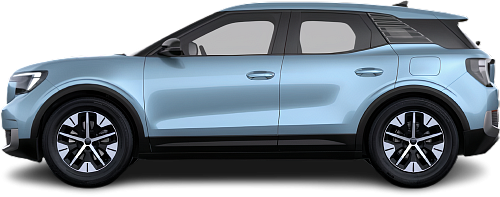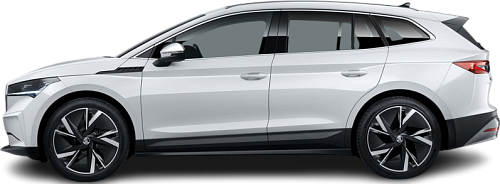USA EV Comparison: Ford Explorer EV Standard Range RWD vs Škoda Enyaq iV 50
Struggling to Decide? Let AI Help!
Your AI Summary Is Ready!
General Info
Although the Ford Explorer EV Standard Range RWD (2024-…) has been announced, it is not yet in production and will not be available for sale in the United States. The Škoda Enyaq iV 50 (2021-2023) has been discontinued, it was never offered for sale in the United States.
The two vehicles share the same body style: SUV.
| Property | Ford Explorer EV Standard Range RWD | Škoda Enyaq iV 50 |
|---|---|---|
| Years of Production | 2024-… | 2021-2023 |
| Current Status | Announced | Discontinued |
| Country of Manufacture | Germany | Czech Republic |
| Body Style | SUV | SUV |
| Market Availability | EU | EU |
| GCC Score | 5.7 | 5.3 |
Range and Efficiency
Although both cars have the same battery capacity, Ford Explorer EV Standard Range RWD (2024-…) achieves a longer real-world range due to its superior energy efficiency.
| Property | Ford Explorer EV Standard Range RWD | Škoda Enyaq iV 50 |
|---|---|---|
| Range (WLTP) | 236 mi | 230 mi |
| Range (GCC) | 201 mi | 193 mi |
| Battery Capacity (Nominal) | 55 kWh | 55 kWh |
| Battery Capacity (Usable) | 52 kWh | 52 kWh |
| Efficiency per 100 mi | 25.9 kWh/100 mi | 26.9 kWh/100 mi |
| Efficiency per kWh | 3.87 mi/kWh | 3.71 mi/kWh |
| Range and Efficiency Score | 6.4 | 6.1 |
Charging
Both vehicles utilize a standard 400-volt architecture.
The Ford Explorer EV Standard Range RWD (2024-…) offers faster charging speeds at DC stations, reaching up to 145 kW, while the Škoda Enyaq iV 50 (2021-2023) maxes out at 50 kW.
The Ford Explorer EV Standard Range RWD (2024-…) features a more powerful on-board charger, supporting a maximum AC charging power of 11 kW, whereas the Škoda Enyaq iV 50 (2021-2023) is limited to 7.2 kW.
| Property | Ford Explorer EV Standard Range RWD | Škoda Enyaq iV 50 |
|---|---|---|
| Max Charging Power (AC) | 11 kW | 7.2 kW |
| Max Charging Power (DC) | 145 kW | 50 kW |
| Architecture | 400 V | 400 V |
| Charge Port | CCS Type 2 | CCS Type 2 |
| Charging Score | 5.9 | 4.3 |
Performance
Both vehicles are rear-wheel drive.
The Ford Explorer EV Standard Range RWD (2024-…) boasts greater motor power and accelerates faster from 0 to 60 mph.
| Property | Ford Explorer EV Standard Range RWD | Škoda Enyaq iV 50 |
|---|---|---|
| Drive Type | RWD | RWD |
| Motor Type | PMSM | PMSM |
| Motor Power (kW) | 125 kW | 109 kW |
| Motor Power (hp) | 168 hp | 146 hp |
| Motor Torque | 229 lb-ft | 162 lb-ft |
| 0-60 mph | 8.6 s | 10.9 s |
| Top Speed | 99 mph | 99 mph |
| Performance Score | 3.2 | 2.5 |
Dimensions
The Škoda Enyaq iV 50 (2021-2023) is longer, but has a similar width and height to the Ford Explorer EV Standard Range RWD (2024-…).
Both models have similar wheelbase lengths.
| Property | Ford Explorer EV Standard Range RWD | Škoda Enyaq iV 50 |
|---|---|---|
| Length | 175.9 in | 183 in |
| Width (with Mirrors) | 81.2 in | 84.6 in |
| Width (w/o Mirrors) | 73.7 in | 74 in |
| Height | 64.2 in | 63.6 in |
| Wheelbase | 108.9 in | 108.8 in |
Cargo and Towing
The Škoda Enyaq iV 50 (2021-2023) provides more cargo capacity, featuring both a larger trunk and more space with the rear seats folded.
Neither car is equipped with a frunk (front trunk).
The Ford Explorer EV Standard Range RWD (2024-…) has a towing capacity of up to 2200 lb, whereas the Škoda Enyaq iV 50 (2021-2023) is not officially rated for towing in the US.
| Property | Ford Explorer EV Standard Range RWD | Škoda Enyaq iV 50 |
|---|---|---|
| Number of Seats | 5 | 5 |
| Curb Weight | 4427 lb | 4270 lb |
| Cargo Volume (Trunk) | 15.9 ft3 | 20.7 ft3 |
| Cargo Volume (Max) | 50.2 ft3 | 60.4 ft3 |
| Cargo Volume (Frunk) | - Cargo Volume (Frunk) | - Cargo Volume (Frunk) |
| Towing Capacity | 2200 lb | - Towing Capacity |
| Cargo and Towing Score | 6.4 | 6.6 |




